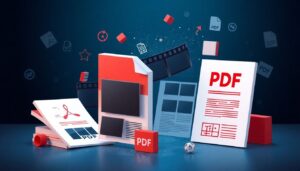
Video content requires significant storage (1GB per hour at HD quality) and poses challenges for efficient information retrieval, with professionals spending 18% of work time searching for specific video segments.
Converting key video frames or transcripts creates compact documentation—reducing file sizes by 98% while maintaining essential information. Educational institutions report 43% improved accessibility when providing lecture summaries in document form. Using a dedicated video to pdf converter enables businesses to create searchable archives with automated timestamping, facilitating compliance with documentation requirements across regulated industries.
Understanding video-to-PDF conversion
When discussing video-to-PDF conversion, clarity about what this process actually entails is essential. Unlike converting between similar formats (such as JPEG to PNG), transforming video to PDF involves fundamental changes in how the content is represented.
Video files are temporal media containing motion, audio, and visual elements that unfold over time. PDFs, conversely, are static documents designed primarily for text and images. This fundamental difference means that a “conversion” is actually a content transformation rather than a simple format change.
There are two primary approaches to this transformation. The first extracts the textual content through transcription, capturing what was said in the video. The second preserves visual elements through screenshots or frame extraction, creating a visual representation of key moments.
Most misconceptions arise from expectations that videos will remain “playable” within PDFs or that the conversion will be lossless. In reality, the process involves decisions about which elements of the video are most important to preserve.
For example, a corporate training video might be converted with emphasis on the spoken instructions, while a product demonstration might prioritize capturing visual steps in a sequence of images. Understanding these differences helps set appropriate expectations for the conversion process.
Limitations of video files
Video files, despite their rich information content, present several practical challenges:
Size constraints make videos difficult to store long-term, with even short HD recordings potentially requiring gigabytes of space.
Sharing difficulties arise when attempting to distribute large files through email or messaging platforms, often requiring compression or specialized hosting services.
Search limitations mean finding specific information within videos is time-consuming, requiring viewers to watch extended footage to locate relevant segments.
Accessibility issues affect users with hearing impairments or those in environments where audio playback isn’t possible. These limitations make video content less versatile than text-based alternatives for many business and educational applications.
Practical methods for video-to-PDF conversion
Converting video content to PDF format can be approached through several practical methods, each with distinct advantages depending on your specific needs.
| Conversion Method | Best Used For | Typical Tools | Complexity Level |
| Transcription-based | Interviews, speeches, lectures, conference calls | Automatic transcription services, speech-to-text AI | Medium |
| Screenshot-based | Tutorials, software demonstrations, visual presentations | Screen capture software, frame extraction tools | Low to Medium |
| Hybrid (text + visuals) | Training videos, detailed explanations, product reviews | Combined solutions or manual workflow | High |
Transcription-based conversion focuses on extracting spoken content from the video and transforming it into text. This method excels when the informational value of the video primarily lies in what was said rather than what was shown. Modern transcription tools can automatically generate text from audio tracks with increasingly impressive accuracy.
Screenshot-based conversion captures key visual frames from the video and arranges them in a document format. This approach works particularly well for demonstrations, tutorials, or presentations where visual elements carry significant meaning.
Hybrid approaches combine both methods, offering the most comprehensive representation of video content. By pairing transcribed dialogue with relevant visual frames, these conversions maintain more of the original context and meaning.
In practice, the method you choose should align with how the information will be used. The most effective conversion strategy considers both the nature of the original content and the intended use of the resulting document.
Automatic transcription services
AI-powered transcription services have revolutionized the process of converting spoken content to text. These systems use sophisticated speech recognition technology to “listen” to audio, identify words and phrases, and convert them to written format with minimal human intervention.
Modern transcription engines employ machine learning algorithms trained on vast datasets of human speech. This training allows them to recognize different accents, speaking patterns, and even specialized terminology with increasing accuracy. Most services can process files in various formats including MP3, MP4, WAV, and other common audio and video file types.
Accuracy considerations remain important when using automatic services. While technology has improved dramatically, factors like background noise, overlapping speakers, or specialized terminology can impact results. Many platforms offer human review options for sensitive or complex content.
When integrated with PDF creation tools, these services streamline the entire conversion workflow. The resulting text can be formatted, indexed, and enhanced with visual elements from the original video, creating comprehensive, searchable documents from multimedia content.
Benefits of converting videos to PDFs
Transforming video content into PDF format addresses inherent limitations of video files and provides numerous advantages for businesses and content creators.
Key benefits of video-to-PDF conversion:
- Dramatic file size reduction – A 30-minute HD video (1.5GB) converts to a PDF document under 5MB
- Searchable content – Locate specific information instantly using keyword search
- Improved accessibility – Compatible with screen readers and assistive technologies
- Enhanced SEO performance – Search engines index text content more effectively
- Cross-platform compatibility – PDFs open consistently across all devices and operating systems
- Simplified archiving – Long-term storage becomes more cost-effective
- Easier content repurposing – Text can be quickly extracted for other publications
The transformation is particularly valuable in educational settings, where lecture recordings can become searchable study materials, and in corporate environments, where meeting recordings can transform into actionable documentation. Organizations with regulatory compliance requirements also benefit from having searchable archives of video content for audit purposes.
Step-by-step guide to creating PDFs from videos
Creating effective PDF documents from video content involves a systematic approach that begins well before the actual conversion process.
Preparing your video is the crucial first step. This includes ensuring audio clarity, organizing content logically, and potentially editing out unnecessary segments that don’t contribute valuable information. Higher quality source material invariably produces better conversion results.
Choosing the right conversion method depends on your content type and intended use. Speech-heavy content benefits from transcription, while visually-oriented videos might require frame extraction or screenshots.
Formatting considerations significantly impact the usability of the final document. Clear headings, appropriate font choices, and consistent layout contribute to readability. For longer videos, consider including timestamps that reference the original footage.
Adding visual elements from the video enhances context and comprehension. Key frames, charts, or diagrams shown in the video can be captured and integrated alongside relevant text portions.
The most effective video-to-PDF conversions maintain the informational integrity of the original while optimizing for the strengths of document formats.
Advanced techniques for optimizing video-to-PDF conversion
For organizations managing substantial video libraries, several advanced techniques can significantly enhance conversion efficiency and quality:
- Custom AI training – Develop domain-specific speech recognition models for industry terminology
- Metadata extraction – Automatically pull video metadata (creation date, location, etc.) into PDF properties
- Semantic analysis – Implement AI to identify and tag key topics and themes within videos
- Quality verification workflows – Create automated processes to flag potential transcription errors
- Time-synchronized bookmarks – Generate PDF bookmarks that link to specific video timestamps
These advanced approaches are particularly valuable for organizations in specialized fields like healthcare, legal services, or technical industries where standard conversion tools may struggle with specialized terminology or have specific documentation requirements.
Conclusion
Video-to-PDF conversion offers practical solutions to common multimedia management challenges. By understanding the realistic possibilities and limitations of this process, organizations can effectively transform their video content into more accessible, searchable, and manageable formats. As conversion technologies continue to improve, the bridge between dynamic and static content becomes increasingly valuable.
Read more:
Video to PDF Converter: Is It Possible? A Realistic Approach to Multimedia Files







